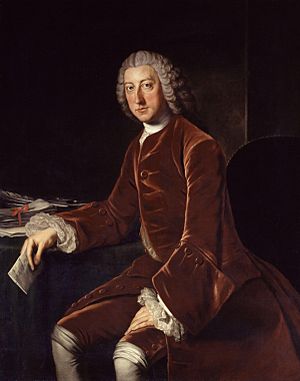Chatham ministry facts for kids
The Chatham ministry was a British government that led the country between 1766 and 1768. It was named after its leader, William Pitt, 1st Earl of Chatham. People sometimes called it the Pitt ministry because Pitt was very famous before he became an Earl. Even though he was seen as the leader, like a Prime Minister, Pitt did not hold the usual top job of First Lord of the Treasury. Instead, he was the Lord Privy Seal.
Contents
What Was the Chatham Ministry?
This government was formed in Britain during the 1760s. It was a time when different groups of politicians, called "factions," often disagreed. William Pitt, Earl of Chatham, wanted to create a government based on "measures, not men." This meant he wanted to choose the best people for the job, no matter which political group they belonged to.
How the Government Started
When Pitt became the leader, he also joined the House of Lords as the Earl of Chatham. He tried to bring together talented people from different political backgrounds. For example, he kept Henry Seymour Conway as Secretary of State from the previous government.
Pitt offered the top job of First Lord of the Treasury to his brother-in-law, Lord Temple. But Lord Temple said no and chose to stay in the opposition. So, Pitt gave the Treasury job to the Duke of Grafton. Pitt's close friends, Lord Camden and Lord Shelburne, also got important roles.
Key People in the Early Ministry
- Duke of Grafton: Became the First Lord of the Treasury.
- Lord Camden: Became the Lord Chancellor, a top legal role.
- Lord Shelburne: Became the Secretary of State for the Southern Department, dealing with foreign affairs.
- Charles Townshend: Became the Chancellor of the Exchequer, in charge of money.
Challenges and Changes
Chatham often suffered from gout, a painful illness, which meant he was sick for long periods. This made it hard for his government to achieve its goals. The idea of "measures, not men" quickly faced problems.
Early Resignations
Soon after the government began, Lord Egmont resigned from the Admiralty. He disagreed with Chatham's foreign policy. Sir Charles Saunders replaced him.
The government also tried to make new alliances in Europe. They wanted to end Britain's isolation from other countries. But Frederick the Great of Prussia turned down their offer to restart an alliance.
Growing Disagreements
Chatham upset some of his allies, the Rockingham Whigs, by firing Lord Edgcumbe. Even though Grafton and Conway stayed, many others from the Rockingham group resigned. Sir Charles Saunders was replaced by the skilled Admiral Sir Edward Hawke.
Many new positions were filled by supporters of Lord Bute. This made the government even less popular. Around this time, Charles Townshend, the Chancellor, suggested new taxes on the American colonies. These taxes, known as the Townshend Duties, caused big arguments within the government.
Chatham's Illness and Ministry Changes
In early 1767, Chatham became very ill and stopped leading the government. The Duke of Grafton tried to keep things running. But it was difficult because three opposition groups had teamed up against them.
Grafton tried to get his former allies, the Rockingham group, to support the government. When that failed, he turned to another group called the Bedfords. This led to major changes in the government in late 1767 and early 1768.
New Faces in the Government
- Lord Gower and Lord Weymouth from the Bedfords joined the government.
- Henry Seymour Conway became a minister without portfolio, meaning he had no specific department.
- Lord Hillsborough was given a new job: Secretary of State for the Colonies. This meant he took over responsibility for the American colonies from Lord Shelburne. Shelburne had different ideas and had stopped attending meetings.
- After Charles Townshend died, Lord North took over as Chancellor of the Exchequer. Lord North also became the leader in the House of Commons.
The End of the Ministry
The Bedfords gained a lot of power in the government. They pushed for a tougher approach towards the American colonies. This was different from what Chatham had originally wanted.
In October 1768, the Bedfords convinced Grafton that Lord Shelburne should be removed from the government. This threat of dismissal made Chatham act. He resigned from his position, and Shelburne also left.
Although Chatham's friend Lord Camden stayed in the government, it was clear that the Bedfords were now in charge. The Duke of Grafton officially became the Prime Minister. He then led the Grafton ministry, which lasted for about a year.
Images for kids



